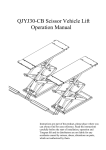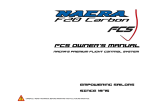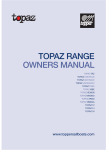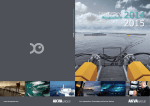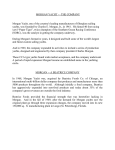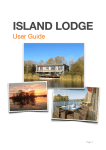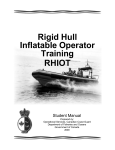Download K2 OWNERʼS MANUAL
Transcript
K2 OWNERʼS MANUAL Stowaway Boats Ltd. 7 Towers Close, Kenilworth, Warwickshire, CV8 1FG Tel. +44 (0)1327 264704 Fax. +44 0870 7063053 Email: [email protected] Website: www.stowawayboats.com INDEX 1. INTRODUCTION 2. SPECIFICATIONS - RYA Examination Report Certificate 2.2 Identification 2.3 Dimension 3. EC Declaration of Conformity 4. SAFETY INFORMATION 4.1 Design Category 4.2 Loading 4.3 Safety Equipment 4.4 Buoyancy Tubes 4.5 Capsize Recovery 4.6 Man Overboard Prevention and Recovery 4.7 Use of an Outboard Engine 4.8 Towing, Anchoring, Mooring and Trailing 5. COMMISSIONING 5.1 Preparation 5.2 Attaching the Main Sail to Boom & Gaff 6 Assembly & Rigging Instructions 7. MAINTENANCE 7.1 Boat Care 7.2 Foil Care (Rudder blade & dagger board 7.3 Spar Care 7.4 Sail Care 8. WARRANTY 1. INTRODUCTION Congratulations on the purchase of your new Stowaway K2 folding sailing dinghy. This manual has been compiled to help you operate your K2 with safety and pleasure. It contains details of the craft; the equipment supplied or fitted, its systems and information on its safe operation and maintenance. Please read it carefully and be sure that you understand its contents before using your K2. If this is your first craft, or you are changing to a type of craft you are not familiar with, for your own safety and comfort, please ensure that you have adequate experience before assuming command of the craft. If you are unsure, your dealer or national sailing federation (RYA in UK) will be able to advise you of a local sailing school, or competent instructor. Please keep this manual in a secure place and hand it over to the new owner if you sell the craft. Please Note the builders plate attached at the stern of the craft. For further information, spares and accessories, please contact your local dealer or: Stowaway Boats Ltd 7 Towers Close Kenilworth Warwickshire CV8 1FG Tel: 01327 264704 Fax: 0870 7063053 Email: [email protected] 2. SPECIFICATIONS 2.1 Identification. Your K2 can be identified by the Craft Identification Number (CIN). You may also assign a sail number and put the sail number on the mainsail itself. This number Is 8,9, & 10th part of your CIN on the next page. The Craft Identification Number, or CIN, is required by European law. The Recreational Craft Directive stipulates that every craft sold in Europe should meet the categories set down by it and display an individual number to show it meets with these rules. Your K2 complies with the RCD to design category D and a CIN is printed on the top of the dagger box and under the boat on the keel near the skeg wheel. 2.2 Dimensions. Length Overall (LOA): 3070mm Beam: 1285mm Folded dimensions: Length 3100mm Width (Max) 480mm Depth 220mm Weights: Weight of folded hull 43.4kg Thwarts, Side seats & transoms15kg Sails, mast, boom and gaff 9kg Rudder tiller 2.8kg Dagger board 3.6kg Sail Area, Main & Jib 5.67 sq.m 3. EC DECLARATION OF CONFORMITY TO DIRECTIVE 94/25/CE I declare that the craft described as: K2 Bearing the Craft Identification Number: G B S F K K 2 0 0 2 F 7 0 Conforms to EU Recreational Craft Directive 94/25/EC Annex 1 – sections 3.2 & 3.3 and Annex 6 – Module Aa EU Notified Body: No. 1681 (Royal Yachting Assoc.) ISO Standards BS EN ISO 10087, 12217, 12215, 10240, 14945, 8666 Trade Marque Stowaway Boats Type K2 Design Category D Maximum Crew 3 Maximum Load 260kg inc. 3 persons at 75kg each, carry on load & outboard engine Overall Length 3.05m Builders Name Stowaway Boats Ltd, England Date __ / __ / __ (The date does not indicate the date of manufacture) Signed Name: ____________________ Signature: _________________ 7 4. SAFETY INFORMATION 4.1 Design Category. The K2 is a Design Category D boat. The definition of this category is: • Design Category: D – ‘inshore’ • Description of Use: Designed for sheltered coastal waters, large bays, estuaries, lakes and rivers. • Wind Force: Up to, and including Beaufort force 4. • Significant Wave Height: up to, and including 1/3 m. The K2 complies with this design category, subject to: • The crew having suitable skill and experience. • Satisfactory construction and maintenance of the boat and its equipment, including the provision of buoyancy provided. Users of this boat are advised that: • All crew should receive suitable training. • The boat should not carry more than the maximum load. • Any water in the hull should be kept to a minimum. • Stability is reduced by any weight added high up (e.g. standing up!). 4.2 Loading. The maximum recommended load for the K2 is 260 kg and the maximum number of crew it can carry is three. The minimum recommended crew weight is 75 kg. 4.3 Safety Equipment. It is your responsibility to ensure that all necessary safety equipment is obtained for the type of sailing you are participating in and it is readily accessible on board while the boat is in operation. Each person should wear a correct size and correctly fitted life jacket or buoyancy aid (a crutch strap is advisable to stop the life jacket riding up). A bailer or other suitable device (e.g. small bucket, plastic milk bottle with opening cut in), should be attached by rope to the boat. A set of oars and paddles is advisable in case you cannot sail or motor the boat. Note: the self draining bailer should be kept shut using the bungee cord provided and only used to expel water when underway at sufficient speed. All crew must ensure their safety, particularly in relation to the boom which could injure and/or render someone unconscious if it swings without warning. This danger may be reduced by wearing a helmet (canoe or cycle variety) and/or putting domestic pipe foam insulation along the boom to spread any impact. 4.4 Capsize Recovery. The capsize is an inevitable part of dinghy sailing and the K2 is no exception. You should practice capsize recovery when you first sail the boat, ideally in an area where there is some kind of safety patrol to assist you, should you get into difficulty. Recovery technique. Should you capsize your K2: • If the dagger board was up, it should be lowered and secured with the bungee cord by a member of the crew. • The jib sheet should be uncleated and made sure that it will run freely when the boat is righted. • The vang should be eased to de-power the top of the mainsail. If the boat inverts, it should be pulled onto its side so that the rig is horizontal to the water. This can be done by pulling on the dagger board using your body weight and placing feet on the underside of the boat. You can slow/prevent the inversion of the boat by attaching a float (e.g. large plastic milk bottle) to the top of the gunter (top of sail) to help keep this on the water rather than sink under it. Recovery: Sailing Solo If possible get hold of a jib sheet or the main sail so that you are attached to the boat. As you start to right the boat, the wind will blow under the mainsail and help you right it. Try to let the sail come out of the water slowly to help turn the boat into the wind, so that there is no wind pressure on the sail when the boat reaches the upright position. If the sail comes up too quickly and there is wind in the sail, it is likely to cause the boat to capsize again. Once the boat is up, still holding onto a sheet enter the boat quickly from the stern and crawl in - bale out as much as you can before proceeding to sail off. Note: Some people permanently attach a rope step (loop) to their boat to be deployed to help them get back on board. Recovery: Sailing with a crew member Position your crew member on the other side of the boat so that when the boat comes up he/she scoops them self into the boat. Get him/her to ensure the dagger board is down and the boat is head to wind, sails flapping freely before attempting to help you on board, whilst keeping the boat level by adjusting his/her weight to the other side until you clamber on. 4.5 Buoyancy Tubes. The K2 is equipped with 3 buoyancy tubes just in case of capsize or swamping. The following points should be noted: • Should a buoyancy tube become punctured, do not use the boat until it is properly repaired. If in any doubt, contact Stowaway Boats for repair details. • Ensure the tubes are strapped through the plastic bridges to the bottom and sides of the hull and adequately inflated. Danger: The boat will sink without adequate buoyancy 4.6 Man Overboard Prevention and Recovery. Working deck. The working deck of the K2, is covered with a non slip coating. Ensure you wear non slip footwear to provide a good grip: Crew overboard recovery. The K2 is designed to be sailed solo or with two persons. However, it can accommodate up to three persons. When sailing it is recommended that you ensure adequate safety cover is in attendance before launching should you or your crew get into trouble. Should one of you fall overboard, be it helm or crew, you should try to gain control of the boat as soon as possible. It may be that the boat has capsized soon after, in which case the crewmember in the water should endeavour to return to the boat to aid in it’s righting. To recover a crew member from the water: • The helm should bring the boat just downwind of the person in the water and then head the boat to wind to stop the boat - let the sails go freely. • The helm should balance the boat, using a combination of body weight movement. • The crew should board the boat via the windward gunwale using a combination of the following handholds: the gunnel and the side seat. 4.7 Use of an Outboard Engine. The K2 is designed for use with an outboard engine. Do not use an engine heavier than 20kg (including fuel) or greater than 3kw (4h.p.). Ensure the engine is bolted on properly to the transom; we strongly advise that you spread the pressure on the fiberglass by using a thin piece of ply either side. Ensure you sit far enough forward to keep the bow just in the water and that you do not suddenly gun the engine in a way that causes the front of the boat to suddenly lift out of the water, thereby creating a danger of capsize. You may choose to put the side tubes on the outside of the boat for extra stability but still ensure that the aft buoyancy tube is fixed internally. 4.8 Towing, Anchoring, Mooring and Trailing. Towing. Should it become necessary to tow the K2, you should follow the procedure below: • Secure the towing line around the base of the mast. If the mast has failed, secure the line around the painter fixing on the bow. • Fully raise or remove the dagger board. • Stay at the tiller. In the event of rudder loss, sit well aft. Anchoring. The K2 is not specifically equipped for anchoring. If you intend to anchor, the anchor line should be secured round the base of the mast or if the boat is not rigged for sailing to the 2 stainless steel eyes on the aft transom so that the boat will swing freely. Mooring. To moor the boat use the painter to secure the front of the boat and another line either passed through a rowlock holder or the "horse" (rope on the aft transom) Trailing. The K2 Is designed to avoid the necessity for a trailer by putting the boat on a roof rack. However if using a trailer tying down the boat to its trailer is important because too much or too little tension could result in damage. Follow the instructions below for safe trailing: • Tie the boat down to the trailer at the bow and across the middle. You only need to apply sufficient tension to hold the boat in contact with the trailer supports. Use padding material where any straps touch the deck and where the boat is touching the trailer.. It is always a good idea to tie the boat down when it is left unattended to prevent any damage to you boat, or any other, in the event of strong winds. 5. COMMISSIONING 5.1 Preparation. Your K2 comes complete with all the components necessary to take the boat sailing. Be careful when opening packaging to ensure you do not damage the contents. Whilst your K2 has been carefully prepared, it is important that you should check that all bolts are tight. This is especially important when the boat is new, as travelling can loosen seemingly tight fittings. It is also important to regularly check such items prior to sailing. 5.2 Attaching the Main Sail to the Boom & Gaff Most people attach the main sail permanently to the boom and gaff and roll the sail up round the boom and gaff and store it with the mast – usually in a sail/spar bag. To attach the main sail Use the white cord provided. 1) Tie the top of the sail to the black plastic bulls eye at the top of the gaff. 2) Tie the middle of the sail to the black plastic bulls eye at the bottom of the Gaff. 3) Tie the bottom leading edge of the sail to the black plastic bulls eye at the front of the boom. 4) Lace the top half of the sail to the gaff using the eyelets and the thin cord (see the first picture) Note: the foot of the sail is attached to a cord which is called the clew outhaul and is threaded through the bulls eye at the aft end of the boom and can be controlled via a jam cleat halfway along the boom. 6 Assembling a Stowaway K2 Step 1 Open boat up preferably on grass to avoid damaging/scratching the fibreglass. Step 2 Insert centre thwart. Step 3 Secure catches on top. Step 4 Secure catches underneath, located either side of centre box. Step 5 Attach Forward Transom (bow plate). Step 6 Secure catch to keel. Step 7 Secure internal side catches. Step 8 Insert forward thwart. Secure catches. ….. and insert locking pin if provided. Step 9 Attach stern transom & secure side catches. Secure catch to keel plate Step 10 Insert stern thwart. Secure catches (& locking pins if provided). Fitting Buoyancy Bags Step 1 Put buoyancy straps through bridges on side and bottom of hull. 8 straps in total: Note: these can be left in the boat when folded away Step 2 Partially inflate and insert stern buoyancy bag first (if provided) – fully inflate once in place and strap in (2 straps). Step 3 Partially inflate the long buoyancy tubes & ensure that they push against the stern bag to hold it in place Keep the inflation valve visible at the bow end for easy access. Step 4 Tighten all straps (these will then be the correct length for future use). Step 5 Fully inflate the tubes. Note: be aware that the bags will expand as the ambient temperature rises & if under too much pressure may puncture. The air in the bags may contract overtime and/or if the ambient temperature drops, requiring extra air to keep them fully inflated; we suggest therefore you take the pump with you when afloat. Note: these buoyancy tubes may be attached to the outside of the boat if preferred. This will provide fendering and also reduce the risk of capsize. However keep the stern bag in position. Securing Side Seats Secure side seats with bolts and wing nuts. …… or drop nose pins if provided. Note: these can be permanently attached to the side seats with wire or string to prevent loss. Insert & secure rowlocks only if rowing. Rigging The Stowaway K2 For Sailing Step 1 Check that the main sail is securing and correctly attached to the boom and gaff (see separate pictures for attaching this; normally the sail is kept on the boom and gaff and stored with the mast. Step 2 Lay the mast in the boat with the foot of the mast near the mast step (on floor of boat). Then secure the 2 side stays using the catches provided. Step 3 Stand the mast upright in the mast step & tension the forestay using the cord. …. then tie off the forestay with 2 half hitches or a clove hitch. Jib Sail Step 4 Secure the top of the jib sail to the uphaul (cord ring to top of mast) as shown in these photographs Step 5 Pull the jib sail up using the front uphaul & at the same time clip the sail onto the forestay as you pull the sail up. Step 6 With the cord remaining from the forestay, secure the jib sail to the bow.. Step 7 Tie off with 2 half hitches or a clove hitch. Main Sail Step 1 Attach boom to mast using split pin. Step 2 Attach gaff to slider, ensure pin is secure. Step 3 Attach uphaul to the lower fitting on the gaff (unless reefing the sail in which case use the higher fitting) Step 4 Haul the gaff up and then thread the thin cord around the mast and back through the eyelets in the front of the sail. Note: check that the cord goes inside the sail uphauls. Step 5 Tie off the cord at the boom. Step 6 Attach vang/kicker to mast. Note: The dagger board should only be put in when the boat is in the water. If the water is shallow, hold the dagger board up using the elasticated cord attached to the front of the centre thwart and securing it to the back of the centre thwart. The rudder/tiller are best put on when the boat is in the water. If not care must be taken not to damage the rudder on the ground. Note: the tiller goes underneath the rope horse. You are now ready to launch the boat. 7. Maintenance 7.1 Boat Care. The K2 is made using fibreglass; the hull floor panels also have a foam sandwich. This is stiff and light, but will dent if subjected to point loading. The boat should be protected when supported on roof bars etc by dense foam (e.g. domestic pipe insulation). Obviously in dealing with a marine environment, equipment gets wet, which in itself is not a problem. The problem starts when moisture is trapped for any length of time. The key, therefore, is to store the boat properly dried off. Water absorption could cause blistering and raised fibre pattern. Keep your dinghy drained and well ventilated. • Ensure the boat is stored with self draining bailer open to allow water to drain away. Wash with fresh water. Fresh water evaporates far more quickly than salt water; so if your dinghy has been sailed in salt water wash it off thoroughly. The fittings will also work better if regularly washed. Be sure to flush any grit out of the boat before folding it to ensure nothing gets trapped in the neoprene rubber hinge. Hull damage falls into three categories: • SERIOUS – large hole, split, crack or worse. Don’t be too distressed! Get the remnants back to our factory – most problems can be repaired. • MEDIUM – small hole or split, gel crazing. If this occurs during an event, sailing can often be continued as long as leaking can be prevented by drying the area and applying strong adhesive tape. CAUTION – if the damage is close to a heavily loaded point then a close examination should be made to ensure joints and laminate are fit for the prevailing conditions. Get the damage professionally repaired as soon as possible. • SMALL – chips, scratching. The owner, using the correct gel coat, can repair this type of damage. As with any dinghy, the loads on blocks and ropes can be immense. As part of your rigging and de-rigging you should check for worn blocks and rope, twisted or bent shackle pins and any other highly loaded parts. 7.2 Foil Care (Dagger board and Rudder Blade). The foils are glass fibre. Look after them as you do the hull. Wash with fresh water regularly. Repair any chips as soon as possible. 7.3 Spar Care. The mast, boom and gaff are anodised aluminium tube. Wash with fresh water. Check all the riveted fittings on a regular basis for any signs of corrosion or wear and check that the bolts on the slider are tight. 7.4 Sail Care. The main should be rolled and stored dry, out of direct sunlight. If your sail is stained in any way, try to remove it using normal detergent and warm water. Repairs should be temporarily made using self-adhesive Dacron, Mylar or spinnaker repair tape (depending on sail type). The sail should be returned to a sail maker for a professional repair. Check for wear and tear, especially around the batten pockets (if battened sail) on a regular basis. 8 WARRANTY This warranty is only available for boats sold directly by Stowaway Boats Ltd, within UK & the EEC. If a boat is sold through a nominated retailer or dealer your redress by law in the first instance is through the seller. 1. This warrantee is given in addition to all rights given by statute or otherwise. 2. Stowaway Boats warrants all boats and component parts manufactured by it to be free from defects in materials and workmanship under normal use and circumstances, and the exercise of prudent seamanship, for a period of twelve (12) months form the date of commissioning by the original owner. The owner must exercise routine maintenance and care. 3. This warranty does not apply to defects in surface coatings caused by weathering or normal use and wear. 4. This warranty does not apply if the boat has been altered, modified, or repaired without prior written approval of Stowaway Boats. Any changes to the hull structure, deck structure, rig or foils without the written approval of Stowaway Boats may void this warranty. 5. The use of the boat for commercial purposes shall void this warranty. 6. Warranty claims for materials or equipment not manufactured by Stowaway Boats can be made directly to the relevant manufacturer. Stowaway Boats warrants that these parts were installed correctly and according to the instructions provided by the manufacturer. 7. Warranty claims shall be made to Stowaway Boats as soon as practicable and, in any event, within 7 days upon discovery of a defect. No repairs under warranty are to be undertaken without written approval of Stowaway Boats. 8. Upon approval of a warranty claim, Stowaway Boats may, at its expense, repair or replace the component. 9. Stowaway Boats reserves the right to change the design, material, or construction of its products without incurring any obligation to incorporate such changes in products already built or in use. 10.Cost of returning goods within the EEC (including the UK) It is the responsibility of the customer to organise and pay for the return and insurance of the goods to the address designated by Stowaway Boats. Stowaway Boats may at its discretion reimburse the customer in part or in full for the return of goods up to the value of the initial carriage cost incurred by Stowaway Boats. If on inspection the problem is considered to be clearly and demonstrably exempted from our guarantee, then Stowaway Boats reserves the right to not reimburse the customer for these return carriage costs and to be paid in advance for the cost of sending goods back to the customer. Stowaway Boats will only pay for the return of goods to the customer its discretion. General Notwithstanding the terms of our guarantee and your statutory rights, our policy is, wherever practical and appropriate, to strive to resolve any problems arising from the manufacture of our products in the most appropriate manner in order to maintain customer satisfaction and our own reputation.


























